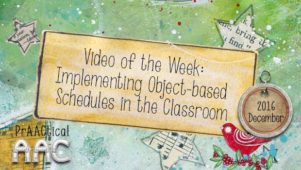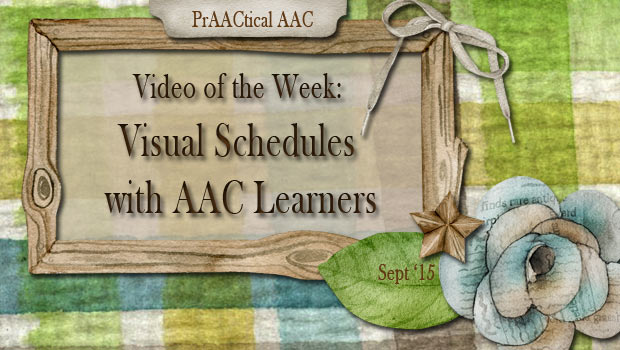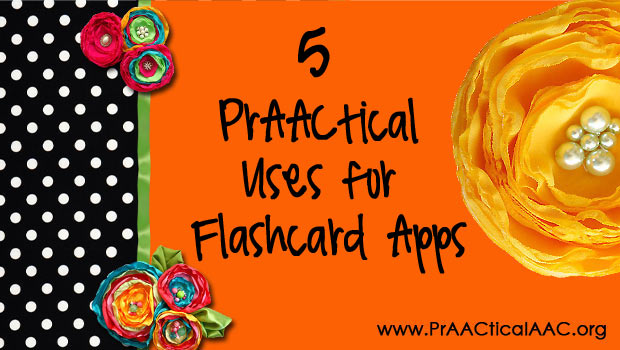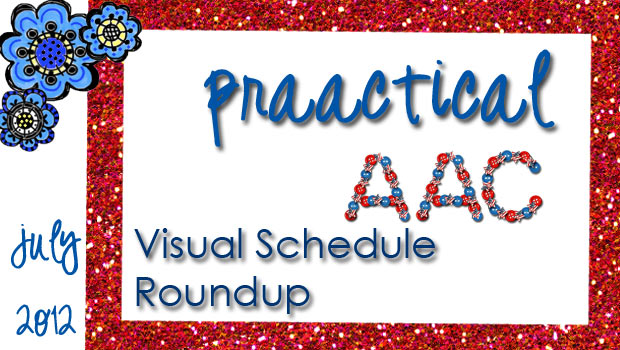Strategy of the Month: Riddle Me This
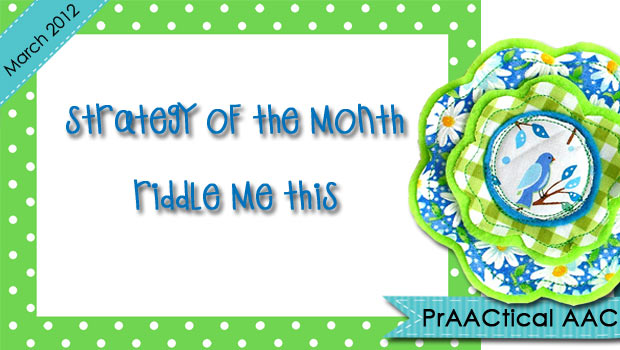
Here’s a riddle for you. Read the clues and guess what tool or strategy we’re talking about.
Clue #1: It’s used in almost every classroom and therapy room serving students with ASD.
Clue #2: The one for Johnny looks almost the same as the one for Jenny.
If you guessed visual schedules, you’ve just named our March Strategy of the Month. Visual Schedules? But everybody already uses those. Why post about those?
—
Here’s why.
–
They’re ubiquitous. And yet when we talk with educators and SLPs about how the children are doing with their schedules, we get a look and a shrug. “Okay, I guess.” To be sure, okay is better than not okay. But visual schedules have so much potential to make lives better for clinicians, educators, and people with AAC needs that okay isn’t good enough. Like our other featured strategies, this one has a good evidence base behind it (e.g., Bryan & Gast, 2000; Massey & Wheeler, 2000; Mesibov, et al, 2000).
–
One final rationale for our choice relates to the target population for visual schedules. Who uses visual schedules? Quite simply…everyone! We love strategies that aren’t exclusively for a special needs population and this certainly meets that criteria.
- Literate, independent, and successful adults use them (check your purse, briefcase, desk, and fridge, and you’ll likely find some version of a visual schedule or calendar).
-
School-aged children use them. “Class, take out your planners and copy the assignment into them.”
- Little kids use them at preschool and, sometimes, at home, too.
If it works for everyone from the college professor to the 9 year old to the preschooler, there has to be a reason. Millions of people wouldn’t be using visual schedules if they weren’t effective. With a tweak here and there, there incredibly effective for people who use AAC, too.
So this month, we focus on making visual schedules that work. Schedules that help your therapy sessions and classroom routines run smoother. First, a quick refresher on what visual schedules are intended to do. Depending on the specifics, our visual schedules have three main purposes:
- Support comprehension: They help the learner know what is going to be happening.
- Support behavior management: It’s a positive way to help learners who have difficulty with transitions cope with movement and change. Knowing what to expect reduces anxiety in all of us.
- Support independence: No one likes to be told what to do. Visual schedules help our AAC friends figure it out for themselves.
–
Second, a basic premise: Visual schedules will only be successful if they are a) tailored to the individual needs of the person and b) implemented consistently.
–
Finally, a prediction: Over the course of this month, we’ll all learn something that makes our use of visual schedules a little bit better.
–
Here’s the plan.
–
Week 1: Visual support basics
Week 2: Individualizing visual schedules to meet the specific needs of the learner. What are the options? when should I consider one versus the others?
Week 3: Bet you can’t have just one. Setting up different types of schedules and why that makes sense for most learners
Week 4: Teaching use of visual schedules. Some tips for putting these tools into action and moving from hand-over-hand to independence
Week 5: Resources and examples. Writing goals for visual schedule use. We’ve got some thoughts but would love to hear from you as well. Share what you’ve done, if you’d like, and we’ll all come away for new ideas.
–
Let’s get this party started!
–
The term, Visual Schedule, refers to an organized way of using graphic representations of events. If an image like the one below popped into your mind, you are in the the majority.
 This photo is typical of the type of visual schedule we see in most therapy spaces and classrooms. There’s nothing wrong with this example as long as people realize that this is just one example. We tend to replicate what we see others do, so this format has become quite popular.
This photo is typical of the type of visual schedule we see in most therapy spaces and classrooms. There’s nothing wrong with this example as long as people realize that this is just one example. We tend to replicate what we see others do, so this format has become quite popular.
–
Actually, visual schedules can be made with various symbols types, and choosing the ‘right’ one depends on the skills and experiences of the person using it. Most clinicians and educators use Picture Communication Symbols (PCS), but schedules can and should be made with other types of AAC symbols, such as SymbolStix or Pixons. They can also be made with photographs, clipart, and object symbols, too. Sometimes we make them with just text/print. In most cases, the symbols on the visual schedule should be the same kind of symbols as those the person uses for their AAC. We’ll look at various examples in the next Strategy of the Month post.
–
Until then, here are those visual schedule basics we promised.
–
For the most part, schedules should have these common elements:
1. A symbol for each activity (or step within the activity). If you’re using pictures, make sure there is a written label for each activity. Symbols should be meaningful to the person using it (e.g., a piece of a seat belt to represent a car ride; a photo of the vending machine where we go for our break at work, a Pixon symbol representing outside for recess, etc.).
2. A way to indicate when a particular activity or step is finished. Putting the symbol into a ‘finished’ pocket is a popular option, but you could also turn it over, move it to another strip, cross it out, cover it up, or check it off.
3. A plan for how it is supposed to be used. Lots of options here (portable schedule that follows the user, stationary schedule with pieces that stay on/near the schedule, stationary schedule with pieces that get moved to the area in which the activity takes place, etc).
–
Here are some basic terms that are used in discussing visual schedules
–
Macro schedules: Used to represent separate activities that will happen in a set period of time. Think of a calendar with activities like going to school, birthday party, or a dentist appointment. Think of a daily schedule brushing teeth, getting dressed, having breakfast, going to the bus stop, etc.
Mini schedules: Also called activity or task schedules, these represent steps of a particular routine or activity. It’s kind of like a visual task analysis: one visual representation for each step of the task, activity, or routine. Think of a pictorial recipe or steps for assembling a bookshelf. We might use this to help the person understand what to do in an art activity or what steps to follow as we go to the cafeteria for lunch (e.g., walk in a line, wait for your turn, take a tray, pick your drink, pick your main dish, pick your fruit, give your lunch ticket, say thank you, etc).
–
In our next post on this Strategy of the Month, we’ll talk about formatting options and how to make decisions in creating visual schedules that work.
–
–
References
Bryan,L. & Gast, D. (2000). Teaching on-task and on-schedule behaviors to high functioning children with autism via picture activity schedules. Journal of Autism and Developmental Disorders, 30, 553-567.
Massey, G. & Wheeler, J. (2000). Acquisition and generalization of activity schedules and their effects on task engagement in a young child with autism in an inclusive preschool classroom. Education and Training in Mental Retardation and Developmental Disabilities, 35, 326-335.
Mesibov, G., Browder, D., & Kirkland, C. (2002). Using individualized schedules as a component of positive behavior support for students with developmental disabilities. Journal of Positive Behavior Interventions, 25, 58-72.
Filed under: Strategy of the Month
Tagged With: schedule, visual schedule
This post was written by Carole Zangari

